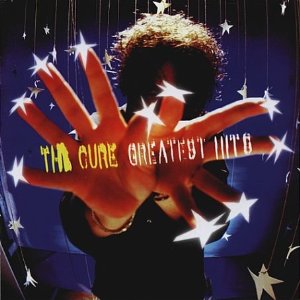This review was first
published on CLUAS in 2002
Other albums reviewed in 2002
The Cure
A review of their 'Greatest Hits' album
 The weirdest, hardest, dirgiest, gloomiest most potent thing about post-punk
pop was the Cure. The Cure was / is also one of the most chaotic and quarrelsome
creations in modern music. It's just a big bloody wonder they managed to produce
ten albums together and come this far to select their greatest hits collection.
The weirdest, hardest, dirgiest, gloomiest most potent thing about post-punk
pop was the Cure. The Cure was / is also one of the most chaotic and quarrelsome
creations in modern music. It's just a big bloody wonder they managed to produce
ten albums together and come this far to select their greatest hits collection.
Led through their various incarnations by guitarist/vocalist Robert Smith, the band became as notorious for their slow, gloomy dirges as they did for the teenage Smith's ghoulish, frizzle-headed appearance. But the public image often hid the diversity of the Cure's music. The teenaged Cure played jagged, edgy pop songs before the group tinkered their way upwards into a more complex and competent machine.
The maturing Cure became the prophet of goth-rock, layering their tunes with lots of guitars and synthesisers. By the time goth caught on in the mid-'80s however, the Cure had moved on, through a series of characteristic reinventions, to become a mainstream attraction on several continents.
Formed in 1976 by schoolmates Robert Smith (vocals, guitar), Michael Dempsey (bass), and Laurence "Lol" Tolhurst (drums) the Cure was born into dark, nervy guitar-pop fed on pretentious pseudo-literary lyrics. Their first demo was a case in point. The Albert Camus-inspired "Killing an Arab" got them a record contract with the legendary A & R man Chris Parry who would release their first album, 'Three Imaginary Boys' in May 1979. The music press liked it and liked the follow-on non-LP singles "Boys Don't Cry" and "Jumping Someone Else's Train" too.
Band changes and a much more experimental palette of sounds characterised the band in mid-life. The addition of keyboards added a new dynamic to the group's sound but, as Cure newcomers will learn from a listen to this collection, the band remained committed to slow, gloomy dirges made palatable by pop hooks which either verged on genius or made the whole mix freaky-likeable.
The latest Cure collection is quite obviously an exercise in money-tree shaking. It will also serve as an ice-breaker, or a consolation perhaps, for the band's desultory return to live work of late (last year's Roskilde festival appearance being a case in point). It'll serve as a great introduction to the band for those who enjoyed their teens in the nineties and thus missed what it was the Cure were all about. But connoisseurs can rest assure that they've got it all already. The 1997 singles collection "Galore" is another alternative to those who aren't sure.
As the street-lively "Lovecats" reminds us here, the better Cure singles were invariably those that diverged from the literary-pretentious and dirgy earlier albums. True to their confusing form, the Cure produced great music however in unlikely moments, as if they tripped across some of their better moments by accident while messing about. Thus the juxtaposition on this CD of the nightmarish "Close to Me," the agit-pop "The Walk," and the brassy "Why Can't I Be You." The ultimate proof of the group's viability, through all the scrapes, lies however in anthemic stuff like "Friday I'm in Love" and the most intelligent condemnation of modern man set to music: "Boys Don't Cry."
